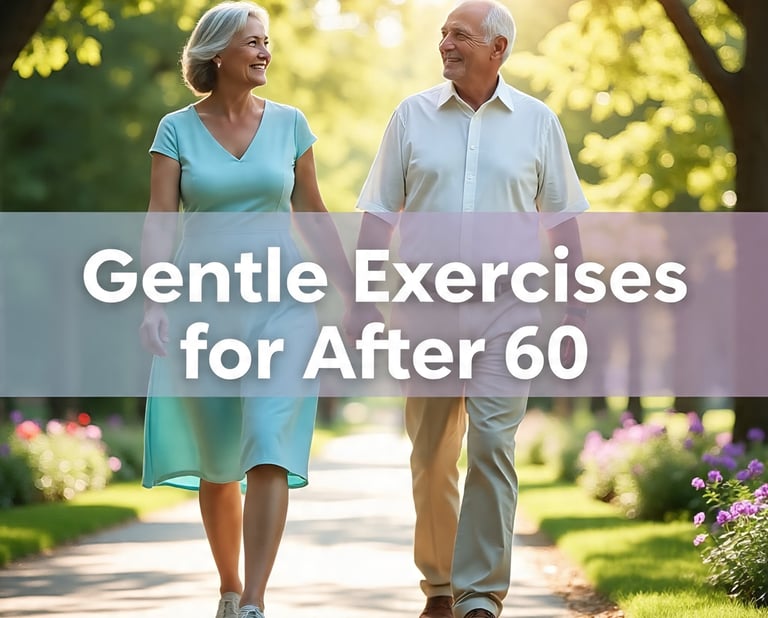Gentle Exercises for Energy and Mobility After 60
Javed Niamat
8/31/20253 min read


Introduction: Moving Gracefully Into Your Golden Years
Reaching 60 is a milestone worth celebrating. For many, it’s a season of greater freedom, wisdom, and new opportunities. But it also comes with changes—our bodies naturally slow down, flexibility declines, and energy levels may dip. The good news? Staying active with gentle exercises can restore vitality, increase mobility, and boost overall well-being. In fact, research from the National Institute on Aging shows that consistent physical activity in older adults reduces the risk of chronic diseases, helps maintain independence, and supports mental health.
This article will guide you through simple, safe, and effective exercises designed specifically for those over 60—whether you’re new to fitness or looking to maintain momentum.
1. Why Exercise Matters After 60
Boosts Energy Levels
As we age, fatigue can become more common. Exercise enhances circulation, delivers oxygen to cells, and triggers endorphins that fight tiredness.
Supports Mobility and Balance
Gentle movement keeps joints lubricated, strengthens muscles, and improves balance—reducing the risk of falls, which are a leading cause of injury among seniors.
Improves Mental Health
Exercise releases “feel-good” hormones, helping reduce anxiety and depression. According to a study published in Frontiers in Psychology, seniors who stay active report higher life satisfaction and a greater sense of purpose.
2. Safety First: Preparing for Exercise
Before beginning any new fitness routine:
Consult your doctor to ensure the exercises are safe for your health condition.
Start slow—listen to your body and increase intensity gradually.
Use supportive footwear to protect your feet and joints.
Stay hydrated—even mild dehydration can affect balance and energy.
3. Gentle Exercises for Energy and Mobility
Here are tried-and-true movements tailored for seniors:
A. Walking: The Simplest Energy Booster
Why it works: Walking improves cardiovascular health, boosts energy, and strengthens legs.
How to start: Begin with 10–15 minutes daily, gradually increasing to 30 minutes.
Tip: Walk with a friend or listen to uplifting music for motivation.
B. Chair Yoga: Flexibility and Peace of Mind
Why it works: Chair yoga helps stretch stiff muscles, improves posture, and reduces stress.
Simple move: Sit tall, raise your arms overhead, and slowly twist side to side. This improves spinal mobility.
Bonus: It enhances mindfulness, combining movement with calm breathing.
C. Strength Training with Resistance Bands
Why it works: Builds muscle strength without heavy weights, reducing the risk of osteoporosis.
Exercise example: Sit in a chair, place a resistance band under your feet, and curl your arms upward to strengthen biceps.
Tip: Aim for 2–3 sets of 10–12 reps, 2–3 times per week.
D. Tai Chi: The Art of Gentle Flow
Why it works: Tai Chi combines slow, flowing movements with deep breathing, improving balance, coordination, and relaxation.
Research: A study in The Journal of Aging and Physical Activity shows Tai Chi reduces fall risk by nearly 50% in older adults.
Action step: Join a local senior-friendly Tai Chi class or follow a guided video at home.
E. Water Aerobics: Joint-Friendly Fitness
Why it works: The buoyancy of water reduces strain on joints while providing resistance for a full-body workout.
Activities include: Water walking, gentle kicks, and arm circles.
Best for: Those with arthritis or joint pain.
F. Stretching for Flexibility
Why it works: Stretching maintains mobility and prevents stiffness.
Simple move: While seated, extend one leg forward and gently reach toward your toes. Hold for 15–20 seconds.
Tip: Incorporate stretches daily, ideally after a walk or warm-up.
G. Breathing Exercises for Energy
Why it works: Deep breathing improves oxygen flow, reduces stress, and increases focus.
Practice: Inhale deeply through your nose for 4 counts, hold for 4, exhale for 6 counts. Repeat 5–10 times.
4. Making Exercise Fun and Sustainable
Find a community: Join a walking group, yoga class, or senior fitness program.
Set small goals: Celebrate progress, whether it’s walking an extra block or holding a stretch longer.
Mix it up: Rotate activities to keep things fresh and enjoyable.
Incorporate faith or mindfulness: Pray, meditate, or listen to uplifting music while exercising.
5. Real-Life Inspiration: Seniors Who Found New Strength
Barbara, 72: Began water aerobics after knee surgery and now enjoys pain-free mobility.
James, 68: Took up Tai Chi and found his balance improved so much he hasn’t had a fall in years.
Linda, 75: Started chair yoga at her church group and says her energy levels are higher than ever.
These stories prove that movement is not just about physical health—it’s about reclaiming joy and independence.
6. The Spiritual Side of Staying Active
For many seniors, faith is an anchor. Scripture reminds us: “So whether you eat or drink or whatever you do, do it all for the glory of God.” (1 Corinthians 10:31). Exercise can be an act of stewardship—caring for the body God has given you.
By moving with intention, you honor your Creator while gaining strength, vitality, and peace.
Conclusion: Your Best Years Can Still Be Active Years
Gentle exercises after 60 are more than just physical routines—they are keys to freedom, vitality, and joy. Whether it’s walking in the park, practicing Tai Chi, or joining a group class, every step you take is an investment in a healthier, happier you.
Remember: It’s never too late to start. Your body was designed to move, and by embracing these gentle exercises, you can enjoy energy, mobility, and a renewed zest for life well into your golden years.